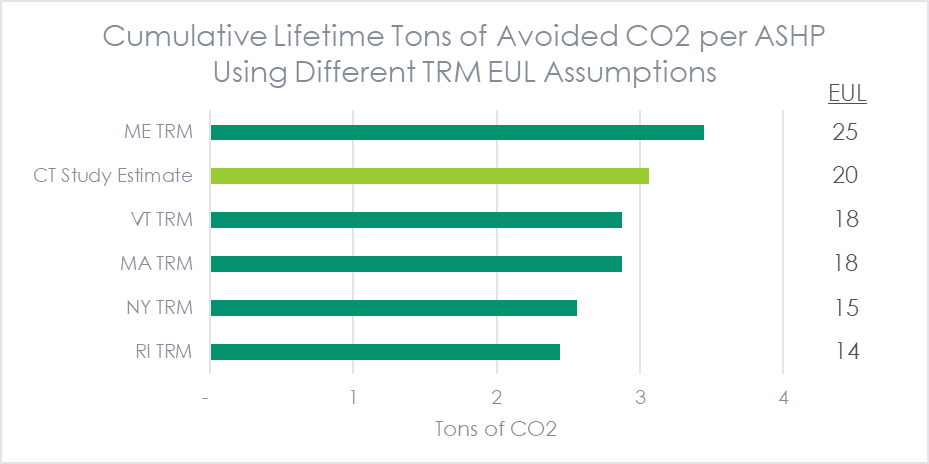Lifetime Carbon Impacts
If we are counting on energy efficiency to account for a large part of reducing carbon emissions, we need to count lifetime savings accurately. Annual CO2 emissions in the US may be leveling off or declining, but CO2 lasts a very long time in the atmosphere and its impacts are cumulative. Additionally, the effects of climate change are time-delayed and will likely be magnified due to feedback loops (e.g., less polar ice to reflect sunlight will lead to higher ocean temperatures). It is therefore crucial to understand how long energy efficient equipment or interventions will last to develop an accurate estimate of lifetime avoided carbon emissions.

Source: EIA
Many research and evaluation activities require tight conformance standards such as sampling for 90/10 confidence and precision levels. However, deemed effective useful life (EUL) estimates are notoriously problematic and the values used are often based on outdated low-rigor studies, unsourced estimates, and broad measure life assumptions only referring to general equipment types like “non-lighting measures.” This results in a wide variety of assumptions used in the industry. For example, the EUL assumptions in New England TRMs for air source heat pumps (ASHPs) range from 14 to 25 years. It is striking to think about how much is spent on estimating the savings of energy equipment down to the tenth of a kilowatt hour when so little is know about how long those savings actually last. Michaels is currently conducting several studies on measure lives and savings persistence to help fill this information gap. For example, our research resulted in updating the EUL value for ASHPs in the state of Connecticut from 18 to 20 years.
An Example
To illustrate the impact of different EUL assumptions, let’s look at the differences in carbon emissions for a typical residential HVAC program. For this exercise, we used conservative assumptions for a new efficient ASHP in Connecticut compared to a baseline heat pump, with annual savings of 856 kWh per unit, an average of 528.2 pounds of CO2 per MWh for the New England eGrid subregion, and line losses of 5.3%.[1] We also assumed that the electric grid would continue to become cleaner over time and assumed a 5% annual reduction in carbon intensity of electric generation per year.
Using these assumptions, we found that this heat pump would result in about 3 tons of avoided CO2 over a 20-year life. (Note that if this efficient heat pump was being compared to old fossil fuel heating rather than a baseline heat pump, the avoided carbon would be much higher!) The main thing to notice is how the cumulative avoided CO2 varies using the values from different New England TRMs.
 Next, let’s bring it up from a single unit to the program level. For this, we looked at the impacts of a program running for five years with 1,000 new installations per year. Using these assumptions, we found that five years of program activity could result in 13,800 tons of avoided CO2 with a 20-year EUL or 11,600 tons with a 15-year EUL.
Next, let’s bring it up from a single unit to the program level. For this, we looked at the impacts of a program running for five years with 1,000 new installations per year. Using these assumptions, we found that five years of program activity could result in 13,800 tons of avoided CO2 with a 20-year EUL or 11,600 tons with a 15-year EUL.

Differences between Lifetime Savings of Energy and Carbon
One important thing to note is that the energy savings impact of a longer measure life is different than the carbon impact. Because the electric grid will continue to become less carbon intensive over time as renewable energy generation replaces fossil fuel generation, a kilowatt hour saved today will avoid more carbon than one saved in the future, like a built in discount rate. For example, equipment that lasts 20 years will save 33% more energy than one that last 15 years, but will only result in 20% less carbon emissions. This is important for several reasons.
- First, it drives home the point that the best time to install energy efficient equipment is today if we want to minimize carbon emissions. The kilowatt hour generated today will most likely lead to more carbon in the atmosphere than one in the future.[2] And any CO2 molecule emitted today will stick around for a very long time, doing its global warming thing.
- Second, many jurisdictions are now setting goals related to lifetime energy savings in addition to annual savings and are consequently prioritizing measures with longer EULs over those with shorter lifetimes. But if avoided carbon emissions are also a goal, then this decision could be leaving lots of carbon savings on the table, including those that may have the lowest cost per ton of avoided CO2.
- Finally, it reinforces the need for more rigorous EUL assumptions so we can better understand the long-term impact of energy efficient measures to make more informed decisions. This is true for both long-lasting measures like HVAC equipment and those with shorter lives like retrocommissioning and behavioral measures.
[1] Based on values from the Connecticut Program Savings Document and the New England subregion of the EPA’s Emissions & Generation Resource Integrated Database (eGrid)
[2] Generally speaking, of course. In real life, the carbon intensity of a kWh varies by location, time of day, and time of year.

